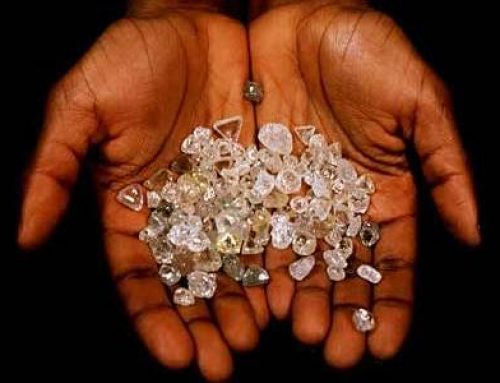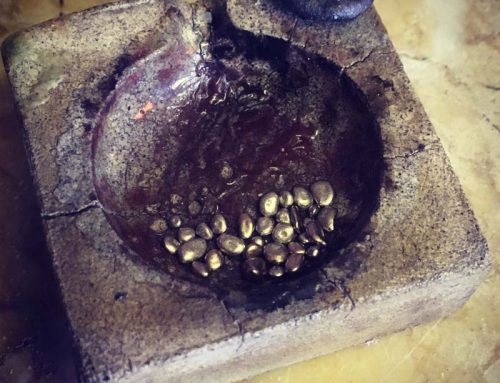TanzaniteOne http://www.tanzaniteone.com/ has announced that they are now producing ethical “mine to market” gems http://www.tanzaniteonegrafgemjointventure.ch/content-n23-sE.html. What exactly do they mean?
TanzaniteOne from an ethical perspective has had a reputation. At the JCK Jewelry Show just a few days ago, I spoke with a journalist who had written a piece for GIA several years ago, which was never published for political reasons, on /TanzaniteOne/ production. He told me (and he asked not to be named) that five years ago, the average age of a tanzanite miner was seven years, and that the average wage was a bowl of rice.
No doubt that this type of behavior is too risky now for a player as major as TanzaniteOne http://www.minesite.com/companies/comp_single/company/tanzanite-one-ltd.html. Regardless of their past conduct, which is not the subject of this piece, I see their concern for ethics now on their website as a positive thing.
Ethical is a very broad word. I have always believed that the term “ethical” carries no real value without specific qualifications. When I was at the Tucson Gem Show http://www.visittucson.org/visitor/events/gemshow/ last February, there was this table set up for ethical jewelry practices in one of the hotels. What they were really concerned about were business ethics — that is, making claims that were accurate — saying a SI1, G diamond is not a SI2, H diamond, for example.
Yet among those who are concerned with using the market of the jewelry sector to support fair trade and the artisan mining sector, ethical practices mean something entirely different. Ethics encompass social justice, environmental responsibility, fair wages and a completely traceable supply chain from the mine, through cutting and polishing and on to the market.
It is hard to tell what TanzaniteOne is claiming. ‘Mine to market’ has become /*the*/ big buzz phrase in the industry — two years ago no one even mentioned the phrase. Probably TanzaniteOne has been mine to market for a long time — controlling their supply chain and working within a tight group of polishers. I don’t think there’s anything wrong with their claiming mine to market custody.
The question I have is, what is behind their “ethical” claims? Are they merely adopting the language of “ethical” without really integrating it into their operations to exemplify best practices in the sector? Are they more or less doing what they always have, but now just trying to market it differently? I can’t tell from looking at their site whether their ethical claim is more than just empty words.
When you read what Eric Braunwart of Columbia Gem House http://columbiagemhouse.com/fairtradegems.html is doing when he claims fair trade, you can see that his claims are really backed up with concrete, admirable policies. His initiative is serious, well thought out and integrated. I myself make claims for fair trade manufacturing and I specify what that means.http://carouselbeads.com/about-carousel-beads/fair-trade-practice
I remember hearing Martin Rapaport http://www.diamonds.net/fairtrade/ talk about these issues at one of his conferences. His view was that if someone makes a fair trade claim, they need to just explain what they are doing transparently. I agree with that view. On the one hand, we should not need to wait if we want to develop our own best practices. Defining these things transparently adds to the discussion, and serves as a valid stepping stone until such time that a third party certification system exists. Clearly this transparency is not the case with TanzaniteOne when they refer to ethics.
Recently, I had a conversation with a sustainability consultant working for a very major brand that conveys class and luxury. This brand wanted this sustainability consultancy to develop a mission/vision statement that encompassed an ethical view. The consultancy, to their credit, refused the assignment, pointing out that such a mission statement, to be meaningful, has to be organically developed within the company. It can’t just be top down. The sustainability company offered to assist, but in the end this major brand did not want to invest the time to really look at themselves.
I suspect we’ll see more and more of these types of disconnections over time. Third party certification in many critical elements in the jewelry production cycle is a long way off. There is no way to evaluate a company’s claim without openness. Large companies will continue to claim themselves to be ethical without purpose and vision integrated vertically into their systems. .





Great article, Marc! I really liked the points you made, and the fairness with which you made them. Educating jewelry makers and designers on what these terms really mean is very important to me, and articles like this help a lot.
Peggy Jo Donahue
Director of Public Affairs
MJSA: Professional Excellence
in Jewelry Making and Design
Hi Marc
We now have a small selection of Tanzanite which we get through our cutter in Dar Es Salaam. We have supplied him with the same safety gear we have at our mine and he pays his guys a wage , food and shared bonus , we have always cut and paid our taxes in Tanzania. ( something I think Tanzanite one were forced to do from December as a result at change of law ) I have been down a local mine 4 years to photograph and seen the conditions which are bad.
Keep up the good work !
[…] Greg Valerio, jeweler, ethical activist and founder of CRED Jewellery points out: “There is no way to evaluate a companies claim to be ethical without […]
Dear Mark,
In response to your article above:
The world’s only tanzanite-producing area is located near Mount Kilimanjaro in Tanzania, Africa. Only 2 kilometres wide and 4 kilometres long, it is split into four sections, named blocks “A” to “D”.
The facts which relate to TanzaniteOne are as below;
Tanzanite One holds the license to mine the largest of four mining blocks – “ Block C”. The remaining blocks on either side are mostly mined by local artisanal miners using non mechanised methods. Block C tanzanite is mined by TanzaniteOne using sophisticated hard rock mining techniques and is currently the deepest purely gemstone mine in the world . Currently at down-shaft depths of up to 900 meters, world class infrastructure has been put in place to secure the shafts, provide air supply, ventilation, and watering and dewatering. A high focus on safety has resulted in a Lost Time Injury Frequency of better than the diamond industry average.
TanzaniteOne workers participate in collective wage and condition bargaining.
Until such time that an international third party certification system is developed which certifies the ethical production of coloured stones, we provide you with the following information to support our guarantee that all TanzaniteOne tanzanite is 100% conflict free, has been responsibly mined and followed an ethical route to market.
Every piece of TanzaniteOne tanzanite has been mined and polished under the conventions of the Tuscon Tanzanite Protocol , Tanzanian employment law and the United Nations ILO Declaration on Fundamental Principles and Rights at Work ( 1998 ) and without the use of child labour.
Environmental monitoring and controls are rigorously adhered to. We minimise environmental impact through several initiatives : ie water we use in reclaimed and recycled, tailings from the mine support the replanting of drought safe native species.
TanzaniteOne provides direct employment to over 650 local Tanzanians. TanzaniteOne Mining Limited has been one of the largest mining contributors to the Tanzanian tax base and has invested over $100million through the mine acquisition, mine development and the Company’s ongoing mining activities over the last 8 years. The Company has already contributed in excess of $23.4million to the United Republic of Tanzania though corporate taxes, royalties and payroll related taxes.
Through a variety of projects, the company works to re-invest in the community in which it operates. The most recent example is the donation of 70% of the funds towards building of a new police station near by.
Through the Tanzanite Foundation ( of which it is a founding member ) TanzaniteOne is committed to giving back to the local community that surrounds the tanzanite mining area, and to date, has built two schools, a medical clinic, and provides fresh water daily to over 4500 heads of cattle. A non profit organisation, The Tanzanite Foundation supplies text books, school supplies and sports equipment, and is also teaching a group of local ladies to make wire wrap jewelry, with tumbled tanzanite donated by TanzaniteOne. A Reverse Osmosis Plant was also recently installed in the local community, which purifies the water from naturally occurring minerals which stunt bone development in children.
For further information on the mine and our community projects please visit tanzaniteone.com/projects or the Tanzanite Foundation website – http://www.tanzanitefoundation.org.
Regards,
Linda Kennedy and Hayley Henning
Richland Resources
Tanzanite Foundation